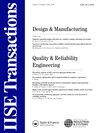数据驱动的传染病实时监测自适应测试资源分配策略
IF 2
3区 工程技术
Q3 ENGINEERING, INDUSTRIAL
引用次数: 0
摘要
自2002年SARS爆发以来,包括正在进行的COVID-19大流行在内的传染病继续成为全球公共卫生的主要威胁。开发有效的数据科学方法以快速发现疾病暴发并遏制其迅速的全球化传播至关重要。然而,在实践中,有限的检测可得性以及因此而产生的检测数据不足,对有效分析和实时监测传染病构成了重大挑战,特别是在一种新型疾病爆发的早期阶段。为了应对这些挑战,本文提出了自适应测试资源分配策略,该策略集成了物理信息模型,以便在不同社区之间动态分配有限的测试资源。基于物理的模型考虑了传播动态和健康差异,尽管数据有限,但仍能进行有效的健康风险评估。通过整合非平稳多臂班迪(MAB)技术,在探索具有高不确定性风险的社区和开发高风险水平的社区之间取得了卓越的平衡,该方法有助于测试分配,以收集高质量的测试数据,用于早期爆发检测。在规则性假设下,对所提出的分配策略的性能进行了理论分析,保证了亚线性或线性动态伪后悔。在三种传输场景下进行了全面的模拟研究,以彻底评估所提出的方法。关键词:数据驱动健康差异传染病多臂班迪实时监测资源分配传播动态免责声明作为对作者和研究人员的服务,我们提供此版本的已接受稿件(AM)。在最终出版版本记录(VoR)之前,将对该手稿进行编辑、排版和审查。在制作和印前,可能会发现可能影响内容的错误,所有适用于期刊的法律免责声明也与这些版本有关。本文章由计算机程序翻译,如有差异,请以英文原文为准。
Data-driven Adaptive Testing Resource Allocation Strategies for Real-time Monitoring of Infectious Diseases
AbstractSince 2002 with the SARS outbreak, infectious diseases, including the ongoing COVID-19 pandemic, have continued to be a major global public health threat. It is critical to develop effective data science methods to quickly detect disease outbreaks and contain their rapid globalized spread. However, in practice, limited testing availability, and thus insufficient testing data poses significant challenges in effective analysis and real-time monitoring of infectious diseases, especially during early stages of a novel disease outbreak. To tackle these challenges, this article proposes adaptive testing resource allocation strategies integrated with a physics-informed model to dynamically allocate limited testing resources across different communities. The physics-informed model accounts for transmission dynamics and health disparities, enabling effective health risk assessment despite limited data. By integrating nonstationary Multi-Armed Bandit (MAB) techniques that strike superior balance between exploring the communities with high uncertain risks and exploiting those with high risk levels, the proposed methodology facilitates test allocation to collect high-quality testing data for early outbreak detection. Theoretical analysis is carried out to evaluate the performance of the proposed allocation strategies, ensuring either sublinear or linear dynamic pseudo-regret under regularity assumptions. A comprehensive simulation study is conducted under three transmission scenarios to thoroughly evaluate the proposed methodology.Keywords: data-drivenhealth disparityinfectious diseasesMulti-Armed Bandit (MAB)real-time monitoringresource allocationtransmission dynamicsDisclaimerAs a service to authors and researchers we are providing this version of an accepted manuscript (AM). Copyediting, typesetting, and review of the resulting proofs will be undertaken on this manuscript before final publication of the Version of Record (VoR). During production and pre-press, errors may be discovered which could affect the content, and all legal disclaimers that apply to the journal relate to these versions also.
求助全文
通过发布文献求助,成功后即可免费获取论文全文。
去求助
来源期刊

IISE Transactions
Engineering-Industrial and Manufacturing Engineering
CiteScore
5.70
自引率
7.70%
发文量
93
期刊介绍:
IISE Transactions is currently abstracted/indexed in the following services: CSA/ASCE Civil Engineering Abstracts; CSA-Computer & Information Systems Abstracts; CSA-Corrosion Abstracts; CSA-Electronics & Communications Abstracts; CSA-Engineered Materials Abstracts; CSA-Materials Research Database with METADEX; CSA-Mechanical & Transportation Engineering Abstracts; CSA-Solid State & Superconductivity Abstracts; INSPEC Information Services and Science Citation Index.
Institute of Industrial and Systems Engineers and our publisher Taylor & Francis make every effort to ensure the accuracy of all the information (the "Content") contained in our publications. However, Institute of Industrial and Systems Engineers and our publisher Taylor & Francis, our agents, and our licensors make no representations or warranties whatsoever as to the accuracy, completeness, or suitability for any purpose of the Content. Any opinions and views expressed in this publication are the opinions and views of the authors, and are not the views of or endorsed by Institute of Industrial and Systems Engineers and our publisher Taylor & Francis. The accuracy of the Content should not be relied upon and should be independently verified with primary sources of information. Institute of Industrial and Systems Engineers and our publisher Taylor & Francis shall not be liable for any losses, actions, claims, proceedings, demands, costs, expenses, damages, and other liabilities whatsoever or howsoever caused arising directly or indirectly in connection with, in relation to, or arising out of the use of the Content. Terms & Conditions of access and use can be found at http://www.tandfonline.com/page/terms-and-conditions .
 求助内容:
求助内容: 应助结果提醒方式:
应助结果提醒方式:


